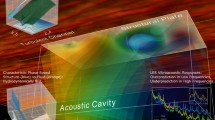Abstract
Flight vehicles such as wheel wells and bomb bays have many cavities. The flow around a cavity is characterized as an unsteady flow because of the formation and dissipation of vortices brought about by the interaction between the free stream shear layer and the internal flow of the cavity. The resonance phenomena can damage the structures around the cavity and negatively affect the aerodynamic performance and stability of the vehicle. In this study, a numerical analysis was performed for the cavity flows using the unsteady compressible three-dimensional Reynolds-Averaged Navier-Stokes (RANS) equation with Wilcox’s turbulence model. The Message Passing Interface (MPI) parallelized code was used for the calculations by PC-cluster. The cavity has aspect ratios (L/D) of 2.5 ∼ 7.5 with width ratios (W/D) of 2 ∼ 4. The Mach and Reynolds numbers are 0.4 ∼ 0.6 and 1.6×10 6, respectively. The occurrence of oscillation is observed in the “shear layer and transient mode” with a feedback mechanism. Based on the Sound Pressure Level (SPL) analysis of the pressure variation at the cavity trailing edge, the dominant frequencies are analyzed and compared with the results of Rossiter’s formula. The dominant frequencies are very similar to the result of Rossiter’s formula and other experimental data in the low aspect ratio cavity (L/D = ∼ 4.5). In the large aspect ratio cavity, however, there are other low dominant frequencies due to the leading edge shear layer with the dominant frequencies of the feedback mechanism. The characteristics of the acoustic wave propagation are analyzed using the Correlation of Pressure Distribution (CPD).
Similar content being viewed by others
Reference
Xin Zhang and John A. Edwards, Experimental Investigation of Supersonic Flow over Two Cavities in Tandem, AIAA J. 30(3) (1992).
K. Krishnamurty, Acoustic radiation from two-dimensional rectangular cutouts in aerodynamic surfaces, NACA, (1955) TN-3487.
J. E. Rossiter, Wind-tunnel experiments on the flow over rectangular cavities at subsonic and transonic speeds, Aeronautical Research Council Reports and Memoranda (1964) 3438.
H. H. Heller, D. G. Holmes and E. E. Covert, Flow-induced pressure oscillations in shallow cavities, Journal of Sound and Vibration, 18 (1971) 545–553.
M. Gharib and A. Roshko, The effect of flow oscillations on cavity drag, Journal of Fluid Mechanics, 177 (1987) 501–530.
M. S. Chingwei and J. M. Philip, Comparison of Two- and Three-Dimensional Turbulent Cavity Flows, AIAA (2001) A01-16385.
J. W. Kim and D. J. Lee, Generalized Formulation and Application of Characteristic Boundary Conditions. 4th AIAA/CEAS Areoacoustics Conference, (1998) AIAA 98-2222.
K. K. Ahuja and J. Mendoza, Effects of cavity dimensions, boundary layer, and temperature in cavity noise with emphasis on benchmark data to validate computational aeroacoustics codes, NASA, (1995) CR-4653.
K. C. Hoffmann and S. T. Chiang, Computational Fluid Dynamics for Engineers, Engineering Education System USA. (1993).
D. C. Wilcox, Reassessment of the Scale Determining Equation for Advanced Turbulence Models, AIAA journal, 19(2) (1988) 248–251.
J. E. Bardina, P. G. Huang and T. J. Coakley, Turbulence Modeling Varidation, Testing, and Development, NASA, (1997) TM-110446.
C. S. Abdol-Hamid, B. Lakshmanan and J. R. Carlson, Application of Navier-Stokes Code PAB3D With Turbulence Model to Attached and Separated Flows, NASA, (1975) Technical Paper-3480.
T. Colonius, A. J. Basu and C. W. rowley, Numerical investigation of the flow past a cavity, AIAA, 99 (1999) 1912.
Clarence W Rowley, Tim Colonius and Amit J. Basu, On self sustaioned oscilaation in two diemensional compressible flow over rectangular cavities, Journal of Fluid Mech. 455 (2002) 315–346.
Woo Chel-hun, Kim Jae-soo and Lee Kyung-hwan, Three dimensional effects of supersonic cavity flow dut to the variation of cavity aspect and width ratios, Journal of Mechanical Science and Technology 22 (2008) 590–598.
Author information
Authors and Affiliations
Corresponding author
Additional information
This paper was recommended for publication in revised form by Associate Editor Do Hyung Lee
Hong-il CHOI received the B.S and M.S degrees in Aerospace Engineering from Chosun University, Korea in 2005 and 2008, respectively. He currently work at KOREA Electric Power Research Institute in Korea
Pa-ul MUN received the B.S in Aerospace Engineering from Chosun University, Korea in 2008. He is currently Candidate for the degree of master of Aerospace Engineering at Chosun University in Korea.
Jae-soo KIM received the B.S in Aerospace Engineering from Seoul National University in Korea in 1981. He then received his M.S and Ph.D. degree in Aerospace Engineering from KAIST in Korea in 1983 and 1987, respectively. He spent one year at Cornell university(USA) as a Post Doc. He worked at Korea Aerospace Research Institute for eight years. Dr. Kim is currently a Professor at the Department of Aerospace Engineering at Chosun University in Korea
Rights and permissions
About this article
Cite this article
Choi, Hi., Mun, Pu. & Kim, Js. Numerical analysis of the subsonic flow around a three-dimensional cavity. J Mech Sci Technol 23, 1702–1709 (2009). https://doi.org/10.1007/s12206-009-0413-5
Received:
Revised:
Accepted:
Published:
Issue Date:
DOI: https://doi.org/10.1007/s12206-009-0413-5



